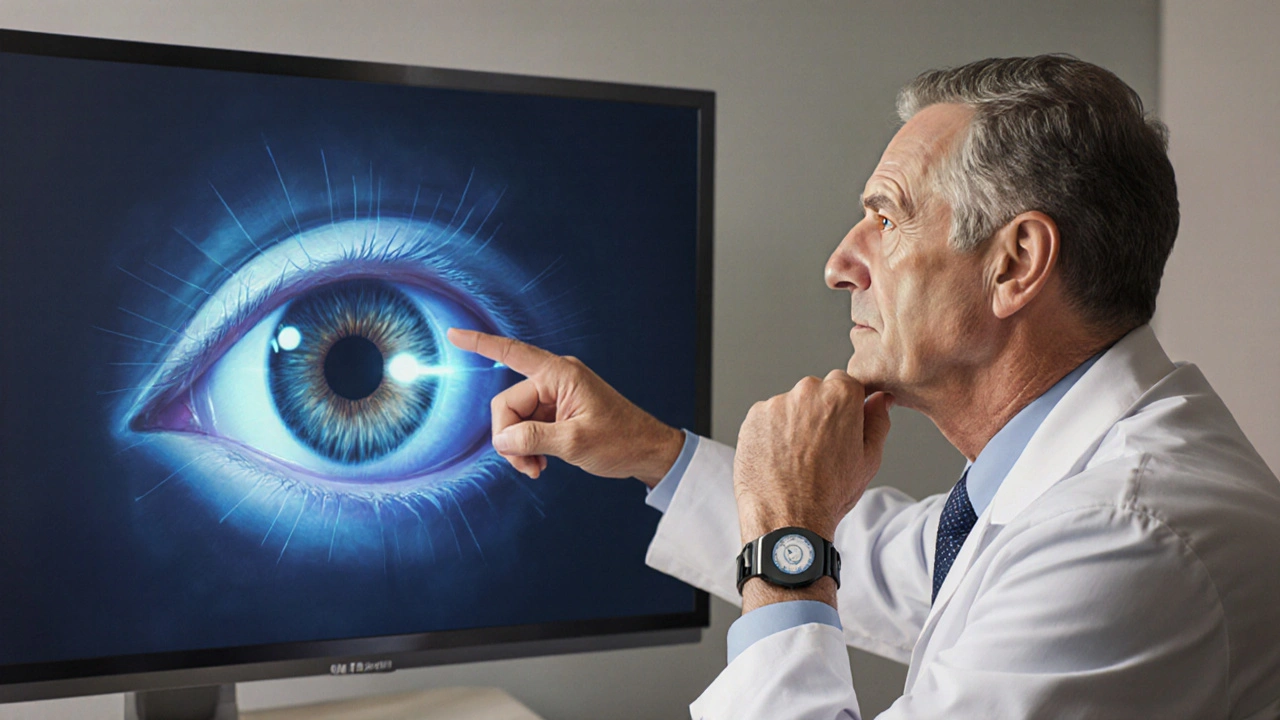How Diabetes Fuels Ocular Hypertension and Increases Glaucoma Risk

Ocular hypertension is a condition characterized by elevated intraocular pressure (IOP) without visible optic nerve damage. It often precedes primary open‑angle glaucoma and can be silent for years. While anyone can develop ocular hypertension, research shows a strong correlation with diabetes mellitus, especially when blood‑sugar control falters.
Why Diabetes Raises Intraocular Pressure
Diabetes impacts eye pressure through several pathways:
- Hyperglycemia increases the osmotic load in the aqueous humor, prompting the ciliary body to produce more fluid.
- Advanced glycation end‑products (AGEs) stiffen the trabecular meshwork, the drainage system for aqueous humor, reducing outflow.
- Systemic hypertension, common in diabetics, raises episcleral venous pressure, which directly pushes IOP upward.
These mechanisms add up, making the average IOP of a diabetic patient about 1.5‑2 mmHg higher than non‑diabetic peers, according to the 2023 International Diabetes Ophthalmology Study.
From Ocular Hypertension to Glaucoma: The Diabetic Edge
Elevated IOP alone doesn’t guarantee glaucoma, but it primes the optic nerve for damage. In diabetics, the optic nerve is already vulnerable because:
- Microvascular disease diminishes blood flow to retinal ganglion cells.
- Oxidative stress from fluctuating glucose spikes accelerates neurodegeneration.
Consequently, a diabetic with ocular hypertension has a three‑fold higher chance of converting to glaucoma within five years compared to a non‑diabetic with the same IOP level.
Key Clinical Markers to Watch
When monitoring a diabetic patient for eye‑pressure issues, clinicians focus on a handful of quantifiable markers:
| Marker | Typical Range (Non‑Diabetic) | Typical Range (Diabetic) | Impact on IOP |
|---|---|---|---|
| HbA1c | 4.0-5.6% | ≥6.5% (often 7-9%) | Higher HbA1c correlates with +0.5mmHg per 1% increase |
| Intraocular Pressure (IOP) | 10-21mmHg | 12-23mmHg | Direct risk factor for glaucoma |
| Blood Pressure | 120/80mmHg | 130/85mmHg (avg.) | Elevated pressure adds ~0.3mmHg to IOP |
| Serum Lipids | LDL <100mg/dL | LDL 130mg/dL+ | Associated with trabecular meshwork dysfunction |
Regularly tracking these markers allows eye care professionals to intervene before pressure spikes become permanent damage.
Diagnostic Tools: How We Measure Eye Pressure in Diabetics
Accurate IOP measurement is critical. The most common technique is tonometry, which comes in several flavors:
- Goldmann applanation tonometry - the gold standard, performed with a slit‑lamp, best for clinic settings.
- Non‑contact (air‑puff) tonometry - quick, useful for screening, though less precise in corneal irregularities often seen in diabetics.
- Dynamic contour tonometry - less affected by corneal thickness, offering an advantage for patients with diabetic corneal edema.
Beyond pressure, diabetics should receive a dilated fundus exam to rule out diabetic retinopathy and assess optic nerve health.

Treatment Strategies Tailored for Diabetics
When ocular hypertension is detected, treatment aims to lower IOP and address the metabolic drivers. Options include:
- Topical prostaglandin analogs - first‑line for most patients; they boost outflow through the uveoscleral pathway. \n
- Beta‑blocker eye drops - reduce aqueous production; caution with diabetic patients on systemic beta‑blockers.
- Carbonic anhydrase inhibitors - useful as adjuncts, especially when prostaglandins are insufficient.
- Lifestyle & glycemic control - tightening HbA1c below 7% often drops IOP by 0.5-1mmHg.
For refractory cases, laser trabeculoplasty or minimally invasive glaucoma surgery (MIGS) can be considered. Studies from 2022‑2024 show that diabetics undergoing laser trabeculoplasty experience a similar IOP reduction as non‑diabetics but may require more retreatments.
Practical Tips for Patients Living with Diabetes
Even with medical care, everyday habits matter:
- Monitor blood sugar daily - sudden spikes raise osmotic pressure in the eye.
- Schedule an eye exam at least once a year, or every six months if you have existing retinopathy.
- Stay active - regular aerobic exercise improves systemic blood pressure and may modestly lower IOP.
- Avoid smoking - nicotine worsens vascular health and can accelerate optic nerve damage.
- Discuss all medications with your ophthalmologist - certain systemic drugs (e.g., steroids) can push IOP higher.
Adhering to these steps can keep eye pressure in check and lower the odds of progressing to glaucoma.
Related Concepts and Next Steps in the Vision‑Health Cluster
Understanding the diabetes‑ocular hypertension link opens doors to deeper topics. Broader themes include "systemic disease impact on ocular health" and narrower ones such as "effect of anti‑VEGF injections on intraocular pressure." Readers interested in the wider picture might explore how hypertension, hyperlipidemia, and obesity intersect with eye disease, while those seeking specifics can dive into the latest guidelines for managing glaucoma in diabetic populations.
Frequently Asked Questions
Does having diabetes automatically mean I’ll develop glaucoma?
No. Diabetes raises the risk, especially when eye pressure is already high, but many diabetics never develop glaucoma. Regular eye exams and good blood‑sugar control keep the risk low.
Can lowering my HbA1c reduce my intraocular pressure?
Yes. Studies show that a 1% drop in HbA1c can lower IOP by about 0.5mmHg. It’s a modest effect, but combined with medication it can be clinically meaningful.
What is the best way to measure eye pressure if I have corneal swelling from diabetes?
Dynamic contour tonometry is less influenced by corneal thickness and edema, making it a reliable choice for diabetic patients with corneal changes.
Are eye‑drop medications safe for people on multiple diabetes drugs?
Most eye drops are safe, but beta‑blockers can interact with systemic beta‑blockers used for heart conditions that some diabetics have. Always inform both your ophthalmologist and endocrinologist.
How often should a diabetic get an eye pressure check?
At least once a year, but if you already have ocular hypertension or diabetic retinopathy, a six‑month interval is recommended.
Does laser trabeculoplasty work as well in diabetics as in non‑diabetics?
The initial IOP drop is comparable, but diabetics may need repeat treatments sooner due to ongoing trabecular meshwork changes.
Can lifestyle changes lower my eye pressure without medication?
Lifestyle can help modestly. Weight loss, regular cardio, and strict blood‑sugar control each contribute to a small but consistent IOP reduction.

Diabetes and eye pressure are a dangerous duo that many overlook. When glucose spikes, the eye's fluid balance gets thrown off, leading to higher intraocular pressure. This pressure silently pushes against the optic nerve, preparing the ground for glaucoma. Add to that the stiffening of the trabecular meshwork from advanced glycation end‑products, and drainage becomes a nightmare. Not to mention systemic hypertension, which further elevates the episcleral venous pressure. All these factors combine to raise the average IOP by about two millimetres of mercury in diabetics. The research shows a three‑fold increase in glaucoma conversion within five years for diabetic patients with ocular hypertension. As clinicians, we must keep a vigilant eye on HbA1c levels because each percent rise nudges IOP upward. Regular tonometry checks should become as routine as blood sugar monitoring for anyone with chronic hyperglycemia. Lifestyle tweaks that improve vascular health also ease the burden on the eye’s drainage system. Patients who manage blood pressure and lipids see a modest but meaningful drop in IOP. Early intervention with prostaglandin analogues can buy precious time before any optic nerve damage occurs. Education is key: many diabetics don’t realize that their eyes need the same level of attention as their kidneys. Empowering patients with this knowledge turns a silent threat into a manageable condition. Stay proactive, stay tested, and keep that pressure low-your vision depends on it!
While the presented data are compelling, it is prudent to acknowledge that correlation does not equate to causation. The mechanisms described, though plausible, require longitudinal validation to substantiate the asserted three‑fold risk increase. Consequently, clinicians should temper enthusiasm with rigorous evidentiary standards.
Whoa!!! Diabetes really turns the eye into a pressure cooker!!! Every glucose surge is like adding extra air to a balloon-boom, pressure spikes!!! And don't even get me started on those nasty AGEs that clog the drainage like a traffic jam!!!
The pathophysiological cascade described aligns with established neuro‑ophthalmic paradigms, particularly concerning trabecular meshwork compliance and episcleral venous outflow resistance. Moreover, the interplay between systemic hypertension and intraocular dynamics underscores the necessity for integrated cardiovascular‑ocular monitoring.
this stuff is total eye‑brain magic lol.
Interesting point, but let’s keep it real-while the science is solid, real‑world patient adherence to frequent IOP checks is often lacking, which can blunt the theoretical benefits.
Great insights! I think it’s encouraging that we have multiple levers to pull-diet, meds, and regular eye exams. If we can keep that pressure down, the future looks clearer for many patients.
One must note that the original post contains several grammatical inaccuracies, such as inconsistent verb tense usage, which detracts from its overall credibility.
Honestly, I think the whole “diabetes = glaucoma” hype is a bit overblown 🤔💭. Sure, there’s a link, but not everyone’s eye is a ticking time bomb 🚨👁️.
Oh sure, because managing blood sugar automatically turns you into a superhero ophthalmologist. 🙄
Thanks for breaking this down so clearly! It really helps to see how each factor contributes to the bigger picture. Keep the great work coming.
In contemplating the interdependence of systemic health and ocular integrity, one is reminded that the body operates as an integrated whole, where neglect in one domain inevitably manifests elsewhere.
From a clinical perspective, the data reinforce the necessity of multidisciplinary coordination between endocrinologists and ophthalmologists to optimize patient outcomes.
One can’t help but wonder if the pharmaceutical industry is quietly capitalizing on these correlations, pushing expensive eye‑drops to a market already primed by chronic disease.
Nice summary! 😊 It really clarifies why we should keep an eye on both glucose and pressure.